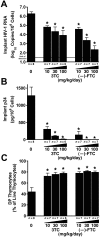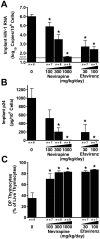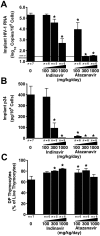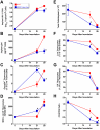Validation of the SCID-hu Thy/Liv mouse model with four classes of licensed antiretrovirals
- PMID: 17668043
- PMCID: PMC1925140
- DOI: 10.1371/journal.pone.0000655
Validation of the SCID-hu Thy/Liv mouse model with four classes of licensed antiretrovirals
Abstract
Background: The SCID-hu Thy/Liv mouse model of HIV-1 infection is a useful platform for the preclinical evaluation of antiviral efficacy in vivo. We performed this study to validate the model with representatives of all four classes of licensed antiretrovirals.
Methodology/principal findings: Endpoint analyses for quantification of Thy/Liv implant viral load included ELISA for cell-associated p24, branched DNA assay for HIV-1 RNA, and detection of infected thymocytes by intracellular staining for Gag-p24. Antiviral protection from HIV-1-mediated thymocyte depletion was assessed by multicolor flow cytometric analysis of thymocyte subpopulations based on surface expression of CD3, CD4, and CD8. These mice can be productively infected with molecular clones of HIV-1 (e.g., the X4 clone NL4-3) as well as with primary R5 and R5X4 isolates. To determine whether results in this model are concordant with those found in humans, we performed direct comparisons of two drugs in the same class, each of which has known potency and dosing levels in humans. Here we show that second-generation antiretrovirals were, as expected, more potent than their first-generation predecessors: emtricitabine was more potent than lamivudine, efavirenz was more potent than nevirapine, and atazanavir was more potent than indinavir. After interspecies pharmacodynamic scaling, the dose ranges found to inhibit viral replication in the SCID-hu Thy/Liv mouse were similar to those used in humans. Moreover, HIV-1 replication in these mice was genetically stable; treatment of the mice with lamivudine did not result in the M184V substitution in reverse transcriptase, and the multidrug-resistant NY index case HIV-1 retained its drug-resistance substitutions.
Conclusion: Given the fidelity of such comparisons, we conclude that this highly reproducible mouse model is likely to predict clinical antiviral efficacy in humans.
Conflict of interest statement
Figures








Similar articles
-
Saquinavir-mediated inhibition of human immunodeficiency virus (HIV) infection in SCID mice implanted with human fetal thymus and liver tissue: an in vivo model for evaluating the effect of drug therapy on HIV infection in lymphoid tissues.Antimicrob Agents Chemother. 1997 Sep;41(9):1880-7. doi: 10.1128/AAC.41.9.1880. Antimicrob Agents Chemother. 1997. PMID: 9303378 Free PMC article.
-
Antiviral activity of 2'-deoxy-3'-oxa-4'-thiocytidine (BCH-10652) against lamivudine-resistant human immunodeficiency virus type 1 in SCID-hu Thy/Liv mice.Antimicrob Agents Chemother. 2000 Mar;44(3):783-6. doi: 10.1128/AAC.44.3.783-786.2000. Antimicrob Agents Chemother. 2000. PMID: 10681360 Free PMC article.
-
Potent activity of the HIV-1 maturation inhibitor bevirimat in SCID-hu Thy/Liv mice.PLoS One. 2007 Nov 28;2(11):e1251. doi: 10.1371/journal.pone.0001251. PLoS One. 2007. PMID: 18043758 Free PMC article.
-
HIV hollow fiber SCID model for antiviral therapy comparison with SCID/hu model.Antiviral Res. 2004 Jul;63(1):1-6. doi: 10.1016/j.antiviral.2004.04.001. Antiviral Res. 2004. PMID: 15196814 Review.
-
Pharmacokinetics of antiretroviral drugs in anatomical sanctuary sites: the male and female genital tract.Antivir Ther. 2011;16(8):1149-67. doi: 10.3851/IMP1919. Antivir Ther. 2011. PMID: 22155899 Review.
Cited by
-
Can the new humanized mouse model give HIV research a boost.PLoS Med. 2008 Jan 15;5(1):e13. doi: 10.1371/journal.pmed.0050013. PLoS Med. 2008. PMID: 18198940 Free PMC article.
-
RAG2-/- gamma(c)-/- mice transplanted with CD34+ cells from human cord blood show low levels of intestinal engraftment and are resistant to rectal transmission of human immunodeficiency virus.J Virol. 2008 Dec;82(24):12145-53. doi: 10.1128/JVI.01105-08. Epub 2008 Oct 8. J Virol. 2008. PMID: 18842716 Free PMC article.
-
In Vivo validation of a bioinformatics based tool to identify reduced replication capacity in HIV-1.Open Med Inform J. 2010;4:225-32. doi: 10.2174/1874431101004010225. Epub 2010 Dec 3. Open Med Inform J. 2010. PMID: 21603285 Free PMC article.
-
Mononuclear phagocyte intercellular crosstalk facilitates transmission of cell-targeted nanoformulated antiretroviral drugs to human brain endothelial cells.Int J Nanomedicine. 2012;7:2373-88. doi: 10.2147/IJN.S29454. Epub 2012 May 8. Int J Nanomedicine. 2012. PMID: 22661891 Free PMC article.
-
Oral administration of the nucleoside EFdA (4'-ethynyl-2-fluoro-2'-deoxyadenosine) provides rapid suppression of HIV viremia in humanized mice and favorable pharmacokinetic properties in mice and the rhesus macaque.Antimicrob Agents Chemother. 2015 Jul;59(7):4190-8. doi: 10.1128/AAC.05036-14. Epub 2015 May 4. Antimicrob Agents Chemother. 2015. PMID: 25941222 Free PMC article.
References
-
- McCune JM, Namikawa R, Kaneshima H, Shultz LD, Lieberman M, et al. The SCID-hu mouse: murine model for the analysis of human hematolymphoid differentiation and function. Science. 1988;241:1632–1639. - PubMed
-
- Namikawa R, Kaneshima H, Lieberman M, Weissman IL, McCune JM. Infection of the SCID-hu mouse by HIV-1. Science. 1988;242:1684–1686. - PubMed
-
- Kitchen SG, Zack JA. HIV type 1 infection in lymphoid tissue: natural history and model systems. AIDS Res Hum Retroviruses. 1998;14(Suppl 3):S235–239. - PubMed
-
- McCune JM. Development and applications of the SCID-hu mouse model. Semin Immunol. 1996;8:187–196. - PubMed
Publication types
MeSH terms
Substances
Grants and funding
LinkOut - more resources
Full Text Sources
Other Literature Sources
Medical
Research Materials

